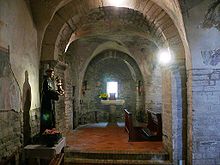
Limigiano
Encyclopedia
Limigiano is a frazione
of the comune
of Bevagna
in the Province of Perugia
, Umbria
, central Italy
. It stands at an elevation of 333 metres above sea level. At the time of the Istat
census of 2001 it had 56 inhabitants.
Limigiano is a rural village, surrounded by large olive groves.
 The main point of interest is the Romanesque abbey church of San Michele Arcangelo. While the foundations are from the 11th century, the current structure dates back to the 13th century. The church was extended and altered through several phases of construction, repair, and maintenance in the Middle Ages. Today the church has a naves and two aisles, each finishing in an apse
The main point of interest is the Romanesque abbey church of San Michele Arcangelo. While the foundations are from the 11th century, the current structure dates back to the 13th century. The church was extended and altered through several phases of construction, repair, and maintenance in the Middle Ages. Today the church has a naves and two aisles, each finishing in an apse
. The church was renovated in 1947 but the beautiful frescoes (some probably by the school of Niccolò Alunno
) are in various stages of deterioration, mostly due to the damages by the earthquake in 1997 and the leaking in of rainwater since then.
Of the medieval castle only a few ruins can be found.
Frazione
A frazione , in Italy, is the name given in administrative law to a type of territorial subdivision of a comune; for other administrative divisions, see municipio, circoscrizione, quartiere...
of the comune
Comune
In Italy, the comune is the basic administrative division, and may be properly approximated in casual speech by the English word township or municipality.-Importance and function:...
of Bevagna
Bevagna
Bevagna is a town and comune in the central part of the Italian province of Perugia, , in the flood plain of the Topino river.Bevagna is 25 km SE of Perugia, 8 km west of Foligno, 7 km north-north-west of Montefalco, 16 km south of Assisi and 15 km north-west of Trevi.It...
in the Province of Perugia
Province of Perugia
The Province of Perugia is the larger of the two provinces in the Umbria region of Italy, comprising two-thirds of both the area and population of the region. Its capital is the city of Perugia...
, Umbria
Umbria
Umbria is a region of modern central Italy. It is one of the smallest Italian regions and the only peninsular region that is landlocked.Its capital is Perugia.Assisi and Norcia are historical towns associated with St. Francis of Assisi, and St...
, central Italy
Italy
Italy , officially the Italian Republic languages]] under the European Charter for Regional or Minority Languages. In each of these, Italy's official name is as follows:;;;;;;;;), is a unitary parliamentary republic in South-Central Europe. To the north it borders France, Switzerland, Austria and...
. It stands at an elevation of 333 metres above sea level. At the time of the Istat
ISTAT
ISTAT may refer to:* International Society of Transport Aircraft Trading, an aircraft standards organization.* Istituto Nazionale di Statistica, the Italian National Institute of Statistics....
census of 2001 it had 56 inhabitants.
Limigiano is a rural village, surrounded by large olive groves.

Apse
In architecture, the apse is a semicircular recess covered with a hemispherical vault or semi-dome...
. The church was renovated in 1947 but the beautiful frescoes (some probably by the school of Niccolò Alunno
Niccolò Alunno
Niccolò Alunno was an Italian painter of the Umbrian school.He was born at Foligno, the son of speziali. He was a pupil of Bartolomeo di Tomaso; his master's assistant was Benozzo Gozzoli, the pupil of Fra Angelico. The simple Umbrian feeling in his work was somehow modified by this Florentine...
) are in various stages of deterioration, mostly due to the damages by the earthquake in 1997 and the leaking in of rainwater since then.
Of the medieval castle only a few ruins can be found.

